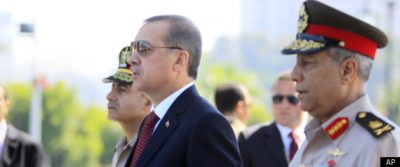[youtube]http://www.youtube.com/watch?v=cUI_Lq4qhcI[/youtube]
Following violent protests in February, Cairo police stacked 10-feet-tall masonry walls around the Ministry of the Interior to cut access to that hated symbol of Egypt’s ousted regime. New barriers appeared after subsequent riots, turning nearby communities into a labyrinth of roadblocks and checkpoints.
Recently, artists “removed” them, overpainting concrete with images of the streetscapes they blocked. In a few days, the “No Walls” protest covered every barrier with a mural. Some residents are sanguine about the obstructions, expecting them to come down as the new government emerges. Others, like these nameless artists, don’t want to wait. Their optical illusions convey a powerful political message: Give us back our streets.
[youtube]http://www.youtube.com/watch?v=ElPuqSu6ttw[/youtube]
Yemen paints over a painful past.
Yemen is one of the poorest Arab countries, with a young, rapidly growing population and soaring unemployment. Following Tunisia’s 2011 revolution and simultaneous with Egypt’s uprising, Yemen’s protests targeted economic conditions and corruption before escalating to demands for governmental reform.
Buildings throughout capital city Sana’a are scarred from year-long conflict that resulted in President Ali Abdullah Saleh stepping down from power last February. City walls were pitted by bullets and scrawled with inflammatory graffiti from both Saleh loyalists and their opposition.
Sana’a artist Murad Subay saw an opportunity to paint a positive backdrop to reform. Using social media, he invited residents to take to the streets and erase the graffiti with colorful paintings. The process of artistic expression gave voice to their desire for peaceful progress, for a return to urban normalcy.
[youtube]http://www.youtube.com/watch?v=LvX0cvwWS8w[/youtube]
West Bank Project spins graffiti into Youth Centers.
Built in 2002, the Israeli West Bank barrier is a favored graffiti site that also spurred a bit of entrepreneurship with a philanthropic goal. Web-based Sendamessage Foundation served as conduit for faraway customers wanting to get their personal messages on that provocative wall. For about $40, a Palestinian painter would make the tag and send the customer a few digital photos of the final work.
Hatched at a Dutch-Palestinian workshop in Ramallah, the wildly popular scheme placed 1498 messages on the wall, with 550,000,000 website hits. A Palestinian non-profit youth group, the Peace and Freedom Youth Forum, masterminded the project, which has now concluded.
Pretty much any commission was accepted: marriage proposals, jokes, shout-outs to distant friends. All extremist, obscene and hate-mongering requests were denied. The project opened a small window to Palestinian lives behind the wall, and offered residents visible proof that their plight is not forgotten.
Graffiti is a peaceful way to protest the barrier and a way to beautify ugliness. One message reads, “Mirror, mirror on the wall. When will this senseless object fall?”, and another shouts, “Get along with each other!”
The group’s largely volunteer Dutch partners maintained the Web site and managed all transactions. Earnings paid for renovation of a West Bank youth center, a fleet of bicycles, a new playground, and laundry facilities for university students in Bir Zeit, near Ramallah.
Since its fall in 1989, hundreds of artists have painted the eastern face of the Berlin Wall. This longest remaining section of that infamous divider, the East Side Gallery, is billed as the world’s biggest open-air art exhibit. Decades after it’s demise, the Berlin Wall illustrates how a flashpoint for political debate can evolve into a powerful stage for creative discourse.
Graffiti explodes during periods of social unrest. In the West, it’s vandalism. In the Middle East, using street art to comment on social and political issues can be a much more dangerous crime.
Green Prophet has shown how Arabic graffiti voices personal and national ideas, inviting people from different backgrounds to connect in a most public forum. With its ready alignment with social media – easily captured images with high visual appeal – street art is emerging as an accessible and entertaining instrument in the political change toolbox.
You can find out more about the history of this artform and its historical role in Middle Eastern revolution in Ard ard (Surface-to-surface): The story of a graffiti revolution by Egyptian writer Sherif Abdel-Megid (Egyptian Association for Books 2011; ISBN 978-977-207-102-9).

